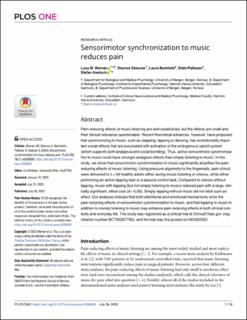| dc.description.abstract | Pain-reducing effects of music listening are well-established, but the effects are small and their clinical relevance questionable. Recent theoretical advances, however, have proposed that synchronizing to music, such as clapping, tapping or dancing, has evolutionarily important social effects that are associated with activation of the endogenous opioid system (which supports both analgesia and social bonding). Thus, active sensorimotor synchronization to music could have stronger analgesic effects than simply listening to music. In this study, we show that sensorimotor synchronization to music significantly amplifies the pain-reducing effects of music listening. Using pressure algometry to the fingernails, pain stimuli were delivered to n = 59 healthy adults either during music listening or silence, while either performing an active tapping task or a passive control task. Compared to silence without tapping, music with tapping (but not simply listening to music) reduced pain with a large, clinically significant, effect size (d = 0.93). Simply tapping without music did not elicit such an effect. Our analyses indicate that both attentional and emotional mechanisms drive the pain-reducing effects of sensorimotor synchronization to music, and that tapping to music in addition to merely listening to music may enhance pain-reducing effects in both clinical contexts and everyday life. | en_US |

